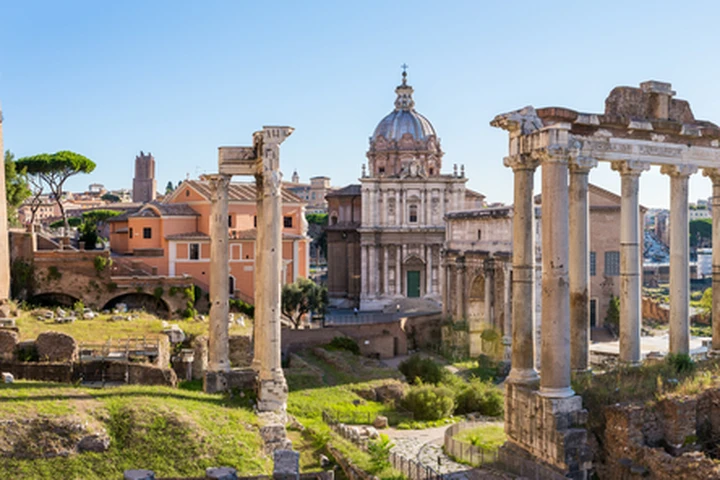Rome
Rome Travel Guide

Rome, the capital city of Italy has a rich and enduring history that spans over 38 centuries. Rome’s cultural and educational significance is evident through its numerous academies, colleges, and universities, making it a major worldwide intellectual and educational center. Rome is a cosmopolitan metropolis that blends ancient with a vibrant contemporary culture. The city has a population of 2.8 million, while the urban area has a population of around 4.2 million.
Things To Know Before Visit Rome
- Italy still relies heavily on cash, especially for smaller purchases and at cafes.
- Beware of sneaky scams.
- Rome boasts an ancient history that comes alive as you explore the city.
- Don’t forget to toss a coin into the Treci Fountain guarantees your return to Rome.
- Dress modestly for holy sites.
- Wild boars are surprisingly common in Rome, especially at night.
- Coffee is a way of life in Italy, and there is a specific way to enjoy it.
- Rome is heaven for delicious Italian food.
Best Hotels In Rome
Here are the best hotels in Rome across different categories:
| Category | Hotel | District | Affordability | Why To Stay There? |
|---|---|---|---|---|
| Budget | Hotel Cortina Rome | Central Rome | From £144 | Classically decorated hotel with a warm atmosphere, free Wi-Fi & a bar. Great for budget-conscious travelers. |
| Mid-Range | Hotel de Russie | Tridente | From £192 | exclusive service, majestic grounds, central location |
| Luxury | Bulgari Hotel Roma | Campo Marzio | From £615 | luxury design, private terraces, Bulgari bath products |
| Near Airport | Terminus Lyon Hotel - Paris | 12th arrondissement | From $94 | Affordable, modern building, relaxed atmosphere, rooftop terrace |
| Near Attractions | Hotel Artemide | 17th arrondissement | From $125 | Sleek rooms, elegant restaurant, refined bar, spa, and central location close to many attractions. Perfect for those who want a stylish and convenient base. |
Where is Rome?
Rome is located in central Italy, in the region of Lazio. It is located in the central area of Italy, close to the country’s Mediterranean western coast.
Where Can You Stay in Rome?
Rome has several areas that are popular for visitors to stay in, depending on their preferences and interests. Some of the best areas to stay in Rome include:
- Historic Center: This area is ideal for first-time visitors, as it is home to iconic landmarks like the Colosseum, Roman Forum, and Pantheon. It is also a great place to experience the atmosphere of one of the greatest cities in the world.
- Trastevere: This charming neighborhood is known for its small cobbled streets and is a great place to stay for those interested in nightlife.
- Monti: This area is an interesting combination of ancient sites and a bohemian neighborhood. It is a great place to stay for families.
- Vatican City/Prati: This elegant residential area is a useful base for St. Peter's Square and the Vatican Museums. It is the best neighborhood for luxury accommodation.
- Colosseum/Monti: This area is a great place to stay for foodies, with many great restaurants to choose from.
- Roma Termini/Esquilino: This is the best area in Rome for budget travelers and those needing quick transit.
- Pantheon/Piazza Navona/Campo de' Fiori: This area is a great place to stay for those who want to be in the heart of the historic center and within walking distance of major sights.
Find cheap hotels in Romewithout a hassle, find great deals and enjoy your trip at its fullest!
Best Places to Visit In Rome
Rome is home to numerous landmarks and historical sites that are worth visiting. Here are some of the best landmarks to visit in Rome:
- Colosseum: One of the most iconic landmarks in Rome, the Colosseum is an oval amphitheater that dates back to AD 72. It was the setting for gladiator combat and major public events.
- Pantheon: Completed by Hadrian in AD 126, the Pantheon is one of the best-preserved buildings from ancient Rome and a masterpiece of Roman architecture.
- Trevi Fountain: The most beautiful and spectacular fountain in Rome, where millions of people visit each year to make a wish.
- Vatican City: Home to St. Peter's Basilica, the Sistine Chapel, and the Vatican Museums, which are a treasure trove of Renaissance art and one of the world's greatest collections of art and antiquities.
- Piazza Navona: A beautiful square in the historic center of Rome, featuring three magnificent fountains and surrounded by elegant Baroque buildings.
- Spanish Steps: A famous landmark in Rome, the Spanish Steps is a beautiful staircase that leads up to the Trinita dei Monti church.
- Palatine Hill: The most famous of Rome's seven hills, Palatine Hill is where, according to legend, Romulus founded Rome and where Lupa raised Romulus and Remus.
Is Rome Safe For Visitors?
Rome is generally considered a safe city for visitors. Petty crime, such as pickpocketing and scams, is the most common safety concern for tourists in Rome.
Is Rome Expensive to Visit?
Rome can be moderately expensive to visit, but costs can vary depending on travel style and preferences. A week-long trip to Rome can cost around $1500 to $2600 for two people, including accommodation, food, and transportation.
Rome Currency
The official currency in Rome, as well as the rest of Italy, is the Euro (EUR).
Rome Language
The language spoken in Rome is Italian, which is derived from Latin.
Rome Time Zone
Rome is in the Central European Time (CET) zone. It’s 1 hour ahead of coordinated Universal; Time (UTC+1).
How Many Days To Visit Rome
The ideal duration for a visit to Rome is 4–7 days to explore Rome’s main attractions, museums, and historical sites at a more relaxed pace. Also allows for day trips to nearby cities and attractions.
The Best Time to Visit Rome
The best time to visit Rome is generally considered to be during April and June, as well as September and October.
- Spring: Spring is a magical time to visit Rome, with peasant weather and fewer crowds.
- Fall: This season offers pleasant weather and is less crowded, making it another ideal time to visit Rome.
- Summer: Summer in Rome can be hot and busy, with a high influx of tourists.
- Winter: while Rome’s winters are cooler and crisp, with fewer tourists, the city’s street life remains vibrant.
What To Pack For Your Visit To Rome?
Clothing:
- Lightweight capris or wide-leg linen trousers for summer
- Breathable shirts and blouses
- Walking shoes
- A light jacket or sweater
- A coat, hat, and gloves for winter
Accessories:
- A cross-body bag
- A travel adapter
- Packing cubes
Toiletries:
- Sunscreen
- Insect repellent
- Bottled water
Other items:
- A guidebook or map for navigating
- A small first-aid kit
- A travel pillow and earplugs
Best Foods In Rome
- L'Amatriciana: A Roman pasta delight, L'Amatriciana features a spicy tomato sauce with guanciale (cured pork cheek) and Pecorino Romano cheese, creating a tantalizing blend of flavors.
- La Carbonara: A creamy Roman pasta dish, La Carbonara is made with eggs, Pecorino Romano cheese, black pepper, and guanciale, delivering a comforting and rich culinary experience.
- Carciofi alla Giudia e Alla Romana: Roman artichokes shine in two ways – deep-fried as Carciofi alla Giudia for a crispy texture, or braised in herbs, garlic, and white wine as Carciofi Alla Romana for a tender, flavorful dish.
- Gnocchi con Sugo di Trapizzino: Roman comfort at its best, Gnocchi con Sugo di Trapizzino combines potato dumplings with a savory meat sauce from a trapizzino, offering a unique blend of textures and flavors.
- Roman Artichokes: Whether deep-fried or braised, Roman artichokes showcase the city's commitment to fresh, seasonal ingredients and traditional cooking methods.
- Pizza: Roman pizza, known for its thin, crispy crust, boasts high-quality ingredients like fresh tomato sauce, mozzarella, and regional toppings, making it a delicious representation of Italian culinary excellence.
- Gelato: A Roman indulgence, gelato offers a variety of flavors in smooth and creamy textures, making it a delightful frozen treat enjoyed by locals and visitors alike.
- Cacio e Pepe: A simple and elegant Roman pasta dish, Cacio e Pepe features a creamy sauce made with Pecorino Romano cheese and black pepper, enhancing the flavor of the pasta.
- Pork Stew: Reflecting Roman warmth, the pork stew is a hearty dish slow-cooked with herbs, tomatoes, and wine, delivering a rich and satisfying culinary experience.
Nightlife in Rome
Rome offers a diverse and lively nightlife scene, catering to a wide range of tastes and references. Some popular nightlife activities in Rome include:
- VinoRoma Wine Studio & Social Club: Ideal for those seeking a budget-friendly yet sophisticated nightlife experience, this wine studio offers a relaxed and social atmosphere, perfect for enjoying a variety of Italian wines.
- Colosseum Bar Hop: For a more dynamic and social experience, the Colosseum Bar Hop provides an opportunity to explore the city's bar scene while connecting with fellow travelers.
- Sant'Eustachio Il Caffè: This historic café is renowned for its exceptional coffee and inviting ambiance, making it an excellent choice for a laid-back evening in the heart of Rome.
- Jerry Thomas Speakeasy: A hidden gem in Rome, this speakeasy offers a unique and immersive experience, complete with expertly crafted cocktails and a stylish, retro atmosphere.
- Borgo Ripa: Known for its lively and energetic atmosphere, Borgo Ripa is a popular spot for those looking to immerse themselves in the local party scene and enjoy a night of dancing and socializing.
- Vinile: This trendy venue is a favorite among music enthusiasts, offering a dynamic mix of live performances and DJ sets, making it an ideal choice for those seeking a memorable night out.

